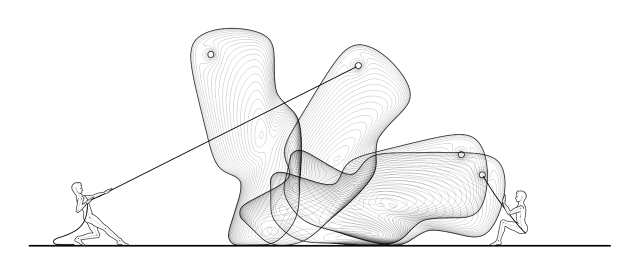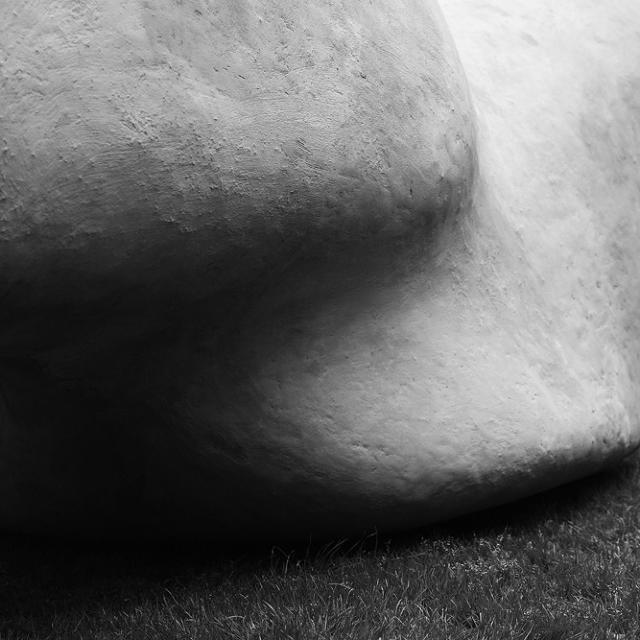Last spring, MIT teaching assistant Carrie Lee McKnelly lost both her parents to a fire. As a tribute, her design students gathered on the university's front lawn to erect a 2,000-pound concrete sculpture that, astonishingly, can move with the flick of a finger.
The sculpture was called the McKnelly Megalith, and it was both a memorial to McKnelly's parents and an experiment aimed at showing how one of the greatest architectural wonders of the world was constructed: the Moai of Rapa Nui, or Easter Island.
Carved starting around 1100 A.D., the Moai of Easter Island weigh up to 82 tons apiece and are believed to honor ancient ancestors. People have long wondered how the natives of Papa Nui managed to move the massive stone carvings across the island from the volcanic quarry in which they were carved without modern machinery. When asked by the Dutch explorers, who discovered the island, how the statues were moved, the Rapa Nui natives always said the same thing: They don't move the stones. The Moai walk themselves. But for centuries, this explanation was considered superstitious poppycock. It's only now becoming generally accepted that the Rapa Nui were telling the truth: Thanks to an assortment of clever ropes, the Moai truly did "walk" from the quarries to their final positions.

The McKnelly Megalith is MIT's way of exploring the methods and math behind the Moai—built as part of the Megalithic Robotics class taught by Brandon Clifford of Matter Design. Yet Clifford's class never set out to make an actual megalith. They merely set out to understand how they were designed. At the beginning of the semester, students were each tasked with finding a precedent or theory on how megalithic structures were moved, be it human power alone, or a very simple machine. They would then take these principles, and produce their own "miniliths" made out of concrete and no larger than 24 inches.
"Generally speaking, in architecture, we're taught to make things that don't move," Clifford says. With megaliths, though, the goal is to design an object which can be precisely shimmied or rolled through calibrated motions to its final resting place. The trick is to identify the center of mass of the medium you're working with. Think of it like a much bigger version of one of those bird toys that balance on the tip of your fingers. Its center of mass is positioned in just such a way that it can easily be spun with a minimum of force.

Nearing the end of the semester, the class had compiled a pretty extensive compendium of techniques that can be used to create man-movable megaliths. But the class only decided to make a megalith themselves when tragedy struck. The death of McKnelly's parents "struck a chord," Clifford says. "Before that, we had no intention of making a larger megalith." Since megalithic architecture tends to commemorate departed ancestors, the class decided to honor the memory of the McKnellies with a megalith of their own.
Students constructed the McKnelly Megalith over the course of a couple weeks. It's made of fiberglass-reinforced concrete with a soft foam core to help prevent it from sinking into MIT's lush grass. At 2,000 pounds, it's not nearly as heavy as a Moai, but it's still heavy enough to validate the Megalith Robotics class's methods.
So over the course of a May afternoon earlier this year, the McKnelly Megalith was moved into place the same way as the Moai were, wobbled into place by a small team of workers at a rate of about 300 feet per hour, then hoisted upright with a rope. The McKnelly Megalith even looks like a post-modern Moai, although Clifford says this anthropomorphic aspect of the sculpture was accidental: the McKnelly Megalith's eye is really just a convenient place to tie a knot for its ultimate hoisting.

As for Clifford, he says the experience of teaching this class has been a profound one for him as an architect. "Going into it, I had a fair amount of skepticism if we should design multi-ton objects to move. But coming out the other side, I'm positive it will impact the way I think about architecture from now on." Say what you want about the Rapa Nui's belief that stone had life of its own, Clifford says, "but treating stone as alive allows for so many different potentials, whether you believe it's literally true or not."